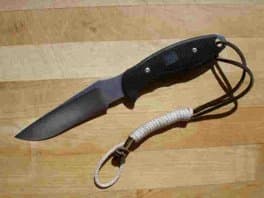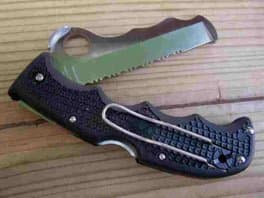A Kayaker's Best Friend - and Tool: A Good Knife!
By Tom Watson
I contend, and will steadfastly debate, that the knife is the second most vital tool a person can have in the outdoor environment - especially the maritime environment. The first tool is, of course, your mind; your ability to think, reason, improvise, etc. In survival mode it's that positive mental attitude that will most likely help you endure and survive. In such situations, the knife comes in a close second as a primary life-saving tool.
It is the single tool that can help you create a wide assortment of other tools - for digging, for hunting or fishing. It can help you gather and/or prepare materials to facilitate devising a shelter. It can be an essential tool in fabricating emergency clothing. It's also a handy tool when it comes to harvesting edible plants and animals - especially maritime critters that can cling to rocks as though they were welded in place.
There are so many knives from which to choose! Blades come in a variety of lengths, grades of steel, shapes, and uses. There are knives with fixed blades, with blades that fold into a handle and even a knife that has two blades that revolve around a central pivoting pin. There are knives with uninterrupted straight edges and there are knives with multiple serrated edges and some with sharpened hooked blades. And there are some with more tools blossoming out from their main housing or handle than the entire hardware section at Sears.
A sharp knife is a safe knife. A well-sharpened blade bites rather than slips and can usually be controlled better. So no matter what type of knife you choose, make sure it will sharpen up to a maintainable edge. Blades are typically made from either carbon steel or stainless steel. Carbon steel is softer so it sharpens easier that does stainless - and the blades tend to wear down quicker, over time, than do the stainless steel ones. Within the category of stainless steel are various grades to consider. Which ever you prefer (stainless is better suited for the salt water environment of kayaking), take some time to learn these differences.
TAHE 10'6 & 11'6 SUP-YAK Inflatables
2-in-1 Kayak & Paddle Board complete packages for single or tandem use.
Knives can be categorized as either having a fixed blade or a folding blade. The classic Bowie knife is a rather large example of a fixed bladed knife. Most diving knives are fixed blades as well. In this type of knife, the blade tang extends back into the handle providing for one-piece construction and structural integrity throughout the knife. It's going to take some mighty severe forces to break the blade. Fixed bladed knives can be used to cut some pretty formidable branches - either by shear cutting power or with the added persuasion of a striking force on the back edge of the blade to drive it down into larger diameter branches.


There are, however, some very high quality folding knives on the market today. The fact that they are compact, come in dozens of styles and utility uses, makes them quite popular. Some can be opened with the quick flick of the thumb; several companies make pocket knife kits that are a tool chest of accessories. The limiting factor with a folding knife is the pin on which the blade pivots. Too much pressure on such blades can cause the pin to snap or the blade to fail at that point.
A common type of knife used at sea has a serrated edge, an advantage when trying to cut through lines, particularly those wrapped around your body during a capsize. Most prudent kayakers have either a folding or a fixed-blade knife - but with the serrated blade - attached to their PFD for quick and easy access in an emergency.
It's important to know how to sharpen a knife (for most knives, use a flat whetstone and draw the blade towards you at a slight angle as though you were cutting off a very thin, uniform slice of the stone) and know how to use it - the right knife for the right job. A dull blade can slip, but is still usually quite sharp enough to cut through clothing and skin.
In a survival mode, without a knife, think of the basic form and function of that tool: a sharpened edge for cutting and a safe way to grip the blade. With that in mind, a thin strip of metal, a shard of glass, chipped pottery, even some sea shells can be formed into serviceable cutting edges. An advantage with glass and some rocks is that you can chip or break off a new edge once the present edge becomes worn. You can also use some fine, but hard-grained, flat rocks to keep a useable edge on most knives.
Besides keeping your knife sharp, a light coating of oil can prevent it from rusting or otherwise corroding. Obviously you want to clean this off, because if you are like most kayakers I know, much of your knife use will be around the campfire during meal preparation. You don't want to slice up some spuds with an oiled knife blade unless you enjoy that rainbow sheen on the water and the petroleum taste throughout your hash browns!
Folding pocket knives can collect lint and grit within the casing and between the blades - grit can get wedged into the tight sides of a knife sheath, too. Part of good knife maintenance is keeping these areas clean as well.
The knife is a wonderful tool. I have several stashed into different parts of my kayaking gear - even one taped to the backrest on my kayak seat. You never know when a knife can come in mighty handy.
Tom Watson is an avid sea kayaker and freelance writer. For more of Tom's paddling tips and gear reviews go to his website: www.wavetameradventures.comHe has written 2 books, "Kids Gone Paddlin" and "How to Think Like A Survivor"that are available on Amazon.com.
Related Articles
This a follow up to a video I did where I talked about differences that you may find in dry and semi-dry…
A few weeks ago we went into a lockdown in New Zealand to deal with Covid-19, I wasn't able to work from…
Over 25 years ago I attended my first kayak "symposium". It was held in a gymnasium in Anacortes,…
Creekboating is as much a game of strategy as it is a sport. Half of your time on creeks is spent…



